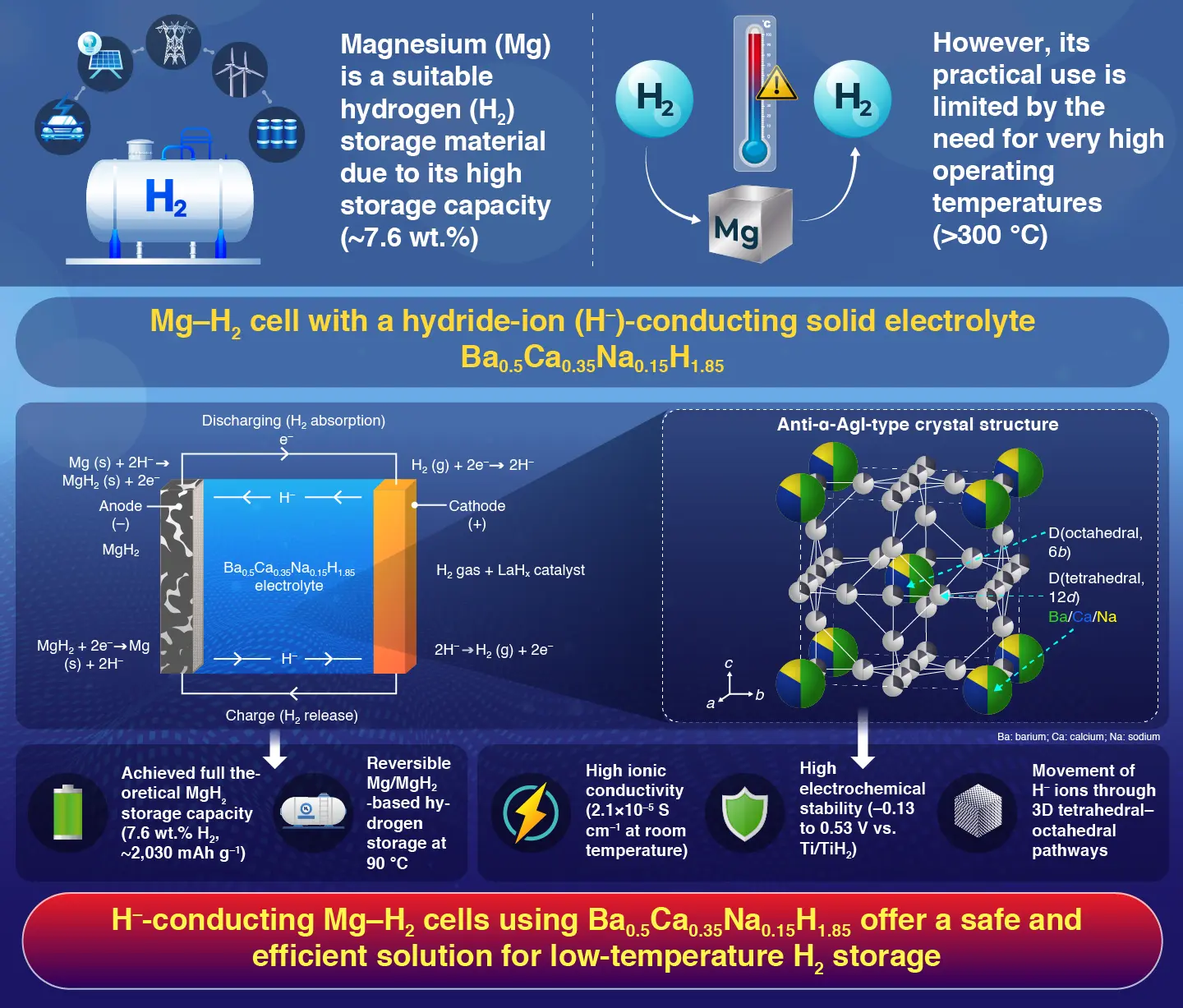A hydrogen battery that operates at just 90 °C has been developed by researchers from Japan, overcoming the high-temperature and low-capacity limits of earlier methods. The device works by moving hydride ions through a solid electrolyte, allowing magnesium hydride, which acts as the anode, to repeatedly store and release hydrogen at full capacity. This battery offers a practical way to store hydrogen fuel, paving the way for hydrogen-powered vehicles and clean energy systems.
Solid Electrolyte for Low-Temperature Hydrogen Storage

Hirose . (2025) | Science | 10.1126/science.adw1996
One of the most pressing challenges facing the use of hydrogen is its storage, which typically requires extremely low temperatures (−252.8 °C) and high pressures (350 to 700 bar). Instead of storing hydrogen as a gas or liquid, a more effective approach is to store it in solid materials such as magnesium hydride (MgH2), which has high theoretical storage capacity. This material can be integrated into a battery-like system where, instead of only moving electrons, hydrogen itself is stored and released during charging and discharging.
Until recently, this approach was limited by the need for high operating temperatures above 300 °C, poor reversibility of hydrogen absorption and desorption, and unwanted side reactions that reduced performance. In a significant development that may open the door to practical applications, researchers from Institute of Science Tokyo (Science Tokyo), Japan, have developed a hydrogen battery that can operate at much lower temperatures, around 90 °C. The study published in the journal Science on September 18, 2025, was conducted by a research team led by Research Scientist Dr. Takashi Hirose, Assistant Professor Naoki Matsui, and Institute Professor Ryoji Kanno at the Research Center for All-Solid-State Battery in Science Tokyo.
"We demonstrated the operation of an Mg–H2 battery as a safe and efficient hydrogen energy storage device, achieving high capacity, low temperature, and reversible hydrogen gas absorption and release," says Matsui.
The novelty of this battery lies in its solid electrolyte, Ba0.5Ca0.35Na0.15H1.85, which can transport hydrogen ions, specifically hydride ions (H–), efficiently. This material has an anti-α-AgI-type crystal structure, well known for its superionic conductivity. In this structure, barium, calcium, and sodium occupy body-centered positions, while H– move through face-sharing tetrahedral and octahedral sites, allowing them to migrate freely. Tests showed that the material has high ionic conductivity at room temperature (2.1 × 10-5 S cm-1) and electrochemical stability, making the system effective for long-term hydrogen storage and release.
The battery design uses MgH2 as the anode and hydrogen (H2) gas as the cathode. During charging, MgH2 releases H–, which migrate through the Ba0.5Ca0.35Na0.15H1.85 electrolyte to the H2 electrode, where they are oxidized to release H2 gas. During discharging, the reverse occurs: H2 gas at the cathode is reduced to H–, which move through the electrolyte to the anode and react with Mg to form MgH2.
This process allows the cell to both store and release H2 when needed, all at manageable temperatures below 100 °C. Using this cell, the researchers were able to reach the full theoretical storage capacity of MgH2, about 2,030 mAh g-1, equivalent to 7.6 wt.% H2, over repeated cycles.
Traditional solid-state hydrogen storage methods have faced major limitations. Heat-driven absorption and desorption required very high operating temperatures between 300 and 400 °C to release or capture hydrogen, which made the process energy-intensive and impractical for everyday use. An alternative approach using electrochemical storage with liquid electrolytes at lower temperatures suffered from poor hydrogen-ion transport, which meant that the materials could not achieve anywhere near their theoretical storage capacities. As a result, both approaches fell short of providing an efficient, reversible, and low-temperature solution for hydrogen storage.
"These properties of our hydrogen storage battery were previously unattainable through conventional thermal methods or liquid electrolytes, offering a foundation for efficient hydrogen storage systems suitable for use as energy carriers," explains Hirose.
Such a battery could be key to a hydrogen-powered future, enabling hydrogen-powered vehicles and carbon-free industries.
Reference
- Authors:
- Takashi Hirose1,2, Naoki Matsui2*, Takashi Itoh1, Yoyo Hinuma2,3, Kazutaka Ikeda4,5,
Kazuma Gotoh6, Guangzhong Jiang2, Kota Suzuki1,2, Masaaki Hirayama1,2, Ryoji Kanno2*
*Corresponding author
- Title:
- High-Capacity, Reversible Hydrogen Storage Using H–-Conducting Solid Electrolytes
- Journal:
- Science
- Affiliations:
- 1Department of Chemical Science and Engineering, Institute of Science Tokyo, Japan
2Research Center for All–Solid–State Battery, Institute of Science Tokyo, Japan
3Department of Energy and Environment, National Institute of Advanced Industrial Science and Technology (AIST), Japan
4Institute of Materials Structure Science (IMSS), High Energy Accelerator Research
Organization, Japan
5Neutron Industrial Application Promotion Center, Comprehensive Research Organization for Science and Society (CROSS), Japan
6Center for Nano Materials and Technology (CNMT), Japan Advanced Institute of Science and Technology (JAIST), Japan






